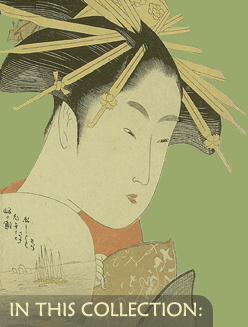 |
During the Edo Period (1615-1868), a uniquely Japanese art from developed known as ukiyo-e, or "pictures of the floating world." A Buddhist concept, ukiyo originally suggested the sadness (uki) of life (yo). But during the peace and prosperity of the 17th century, another ideograph, also pronounced uki but meaning "to float," emerged. Instead of connoting sadness, ukiyo came to be associated with the momentary, worldly pleasures of Japan's rising middle class. Unable to alter their social standing and regulated in nearly every aspect of their lives, from behavior and dress to the sizes of their houses, wealthy commoners found escape in licensed pleasure quarters and Kabuki theaters. There, they could watch handsome actors performing the latest plays or spend time with beautiful courtesans known for their sparkling wit, musical accomplishments, and poetry.
Paintings of people from this world became a specialized type of genre painting in the 17th century. For the first time in Japan's history, commoners had enough money to commission works that reflected their own interests and activities. They patronized artists who created a new style based on sinuous lines and bright colors that featured subjects wearing the most up-to-date fashions and hairstyles.
Soon, these artists also did woodblock prints as inexpensive alternatives to paintings, making ukiyo-e available to everyone. At first, they used only black ink for their images, but by the 1760s they had developed techniques for printing up to twenty colors. They called these works nishiki-e, or brocade prints.
The realization of any print, however, depended on a collaboration: of a publisher, who funded the project; an artist, who designed the image; and block carvers and printers, who produced it. This division of labor, in fact, led to a high degree of technical perfection. While demand for images of beautiful women and dashing Kabuki actors remained strong throughout the 18th century, artists in the 19th century expanded the ukiyo-e repertoire to include landscapes, birds-and-flowers, legendary heroes, and even ghoulish themes.

For the first time in Japanese history, a rising class of city dwellers had the financial means to support an art of their own - an art which reflected their interests and tastes
|
|